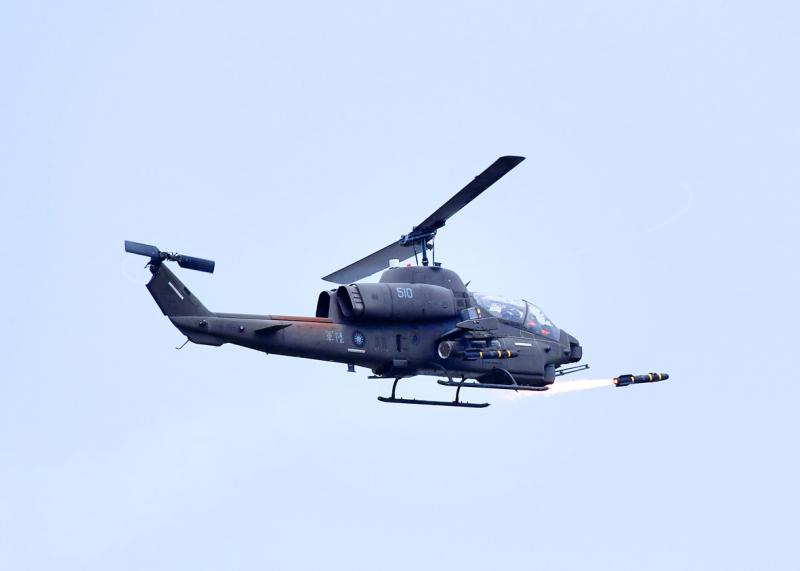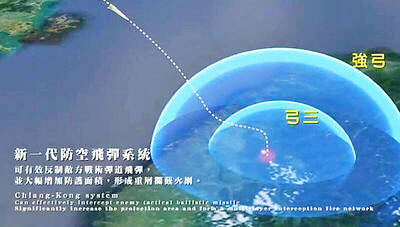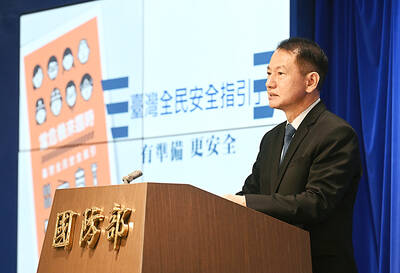The Executive Yuan yesterday unveiled its budget proposal of NT$2.16 trillion (US$73.13 billion) for fiscal 2021, which includes NT366.8 billion for defense expenditure, an increase of NT$15.6 billion, or 4.4 percent, from this year.
If including payment for the F-16Vs that the nation has committed to purchase from the US, which totals NT$29 billion and would be drawn from a special budget, and non-profit special funds of NT$57.6 billion, the defense budget for next fiscal year would be NT$453.4 billion, or 2.4 percent of this year’s projected GDP, the Directorate-General of Budget, Accounting and Statistics said.
Social welfare policies would have the largest slice of the budget at NT$559.4 billion, or 25.9 percent of the projected expenditure, followed by education, culture and science-related expenses, which total NT$429 billion, or 19.9 percent.

Photo: CNA
The funding for economic policies would account for the fifth-largest proportion of the budget at NT$253.9 billion, or 11.7 percent.
The budget for the third phase of the Forward-looking Infrastructure Development Program is NT$230 billion, which would be used to finance urban planning and construction, rail construction, water facilities and digital infrastructure.
An estimated NT$659.2 billion would go toward policies for the construction of a “social safety net,” up NT$59.9 billion from this fiscal year, and NT$534 billion would be spent on infrastructure projects, an increase of NT$96.2 billion growth from this year.
The budget earmarked for measures to address the nation’s low birthrate is NT$60 billion, a rise of NT$10 billion, or 20.3 percent from this year.
The Ministry of National Defense attributed the bump in the defense budget to increases in maintenance expenses and investment.
The budget increase demonstrates the nation’s commitment to asymmetric warfare and to attain defense autonomy, the ministry said in a statement.
Meanwhile, estimated revenue for next fiscal year is NT$2.04 trillion, NT$116.5 billion less than the projected expenditure.
Including the fixed NT$85 billion earmarked annually for national debt repayment, government debt is expected to total NT$215 billion, the DGBAS said.
The shortfall in revenue is expected to stem from reductions in tax revenue, as the government has allowed businesses and individuals affected by COVID-19 to delay income tax payments, it said.
The debts would be offset by borrowing NT$191.5 billion, in addition to NT$10 billion tapped from surpluses from previous fiscal years.
Although government spending this year swelled due to work to prevent the spread of COVID-19 and to bail out businesses affected by the pandemic, the nation’s debt-to-GDP ratio of 32.6 percent is still 8 percentage points lower than the statutory 40.6 percent ceiling, the DGBAS said.
Defense spending has been of renewed interest amid an uptick in Chinese military activity near Taiwan this year.
Beijing yesterday said it had conducted military exercises in the northern and southern ends of the Taiwan Strait in recent days.
The exercises were necessary measures to uphold Chinese sovereignty in the region, the People’s Liberation Army (PLA) Eastern Theater Command spokesman Zhang Chunhui (張春暉) said in a statement.
Certain nations have been sending the wrong signal to pro-Taiwan independence groups and this has severely threatened regional stability and peace, Zhang said, a day after a delegation led by US Secretary of Health and Human Services Alex Azar left Taiwan on Wednesday.
“Taiwan is an inseparable and integral part of China’s territory and our drills and exercises are necessary based on the current situation across the Taiwan Strait,” he said.
The military exercises focused on joint-forces combat capability, he said, adding that the PLA would take all necessary action to prevent any action by pro-independence factions and defend the nation’s sovereignty and territorial unity.
In Taipei, the defense ministry called for calm, saying it was monitoring all sea and air activities, which are normal.
Stable cross-strait relations are the cornerstone for regional peace and the military is capable and willing to defend Taiwan’s democratic freedoms and sovereignty, it said.
Additional reporting by CNA

LIMITS: While China increases military pressure on Taiwan and expands its use of cognitive warfare, it is unwilling to target tech supply chains, the report said US and Taiwan military officials have warned that the Chinese People’s Liberation Army (PLA) could implement a blockade within “a matter of hours” and need only “minimal conversion time” prior to an attack on Taiwan, a report released on Tuesday by the US Senate’s China Economic and Security Review Commission said. “While there is no indication that China is planning an imminent attack, the United States and its allies and partners can no longer assume that a Taiwan contingency is a distant possibility for which they would have ample time to prepare,” it said. The commission made the comments in its annual

DETERMINATION: Beijing’s actions toward Tokyo have drawn international attention, but would likely bolster regional coordination and defense networks, the report said Japanese Prime Minister Sanae Takaichi’s administration is likely to prioritize security reforms and deterrence in the face of recent “hybrid” threats from China, the National Security Bureau (NSB) said. The bureau made the assessment in a written report to the Legislative Yuan ahead of an oral report and questions-and-answers session at the legislature’s Foreign Affairs and National Defense Committee tomorrow. The key points of Japan’s security reforms would be to reinforce security cooperation with the US, including enhancing defense deployment in the first island chain, pushing forward the integrated command and operations of the Japan Self-Defense Forces and US Forces Japan, as

INTERCEPTION: The 30km test ceiling shows that the CSIST is capable of producing missiles that could stop inbound missiles as they re-enter the atmosphere Recent missile tests by the Chungshan Institute of Science and Technology (CSIST) show that Taiwan’s missiles are capable of intercepting ballistic missiles as they re-enter the atmosphere and pose a significant deterrent to Chinese missile threats, former Hsiung Feng III missile development project chief engineer Chang Cheng (張誠) said yesterday. The military-affiliated institute has been conducting missile tests, believed to be related to Project Chiang Kung (強弓) at Pingtung County’s Jiupeng Military Base, with many tests deviating from past practices of setting restriction zones at “unlimited” and instead clearly stating a 30.48km range, Chang said. “Unlimited” restrictions zones for missile tests is

PUBLIC SAFETY: The nationwide distribution campaign aims to enhance society’s overall understanding of threats and bolster defense awareness, an official said The latest edition of the National Public Safety Guide is being mailed to all citizens starting today to foster public awareness of self-defense in the event of war or natural disasters, the Ministry of National Defense said yesterday. “The guides will be disseminated to the public to enhance society’s overall understanding of threats and bolster defense awareness, demonstrating the government’s emphasis on people’s safety and its determination to pursue self-defense,” All-out Defense Mobilization Agency Director Shen Wei-chih (沈威志) said at the ministry’s news conference. The nationwide distribution campaign was planned according to President Lai William’s (賴清德) Sept. 20 directive, he said, adding